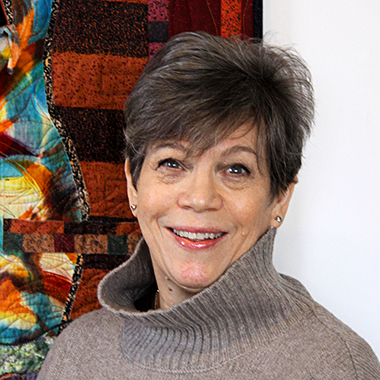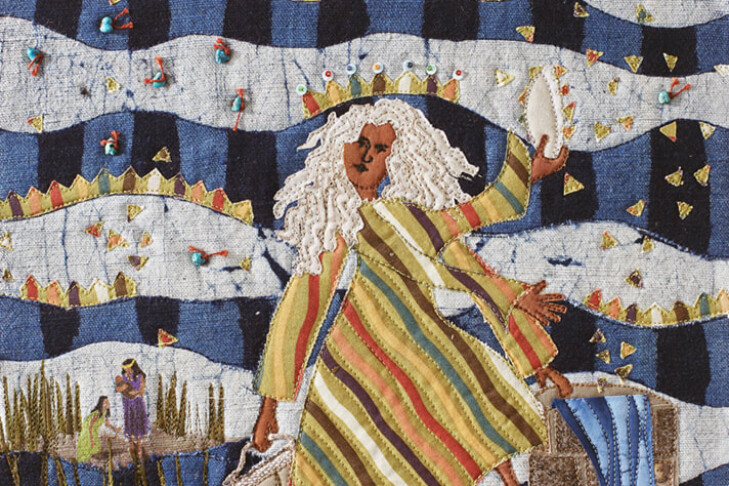“One way we understand our world is through stories; another is through art. Torah is the story of the Jewish people—parts of it historical, parts political, parts allegorical, parts mystical, parts poetic. It is also a piece of my personal history.”
Artist Anita Rabinoff-Goldman had never read the Torah from start to finish. When she moved to Boston from Albany four years ago, she decided it was time.
“It was a new year, I was in a new place, and it was a new opportunity to dive in. I started at Simchas Torah and read the Torah portion every week. Then, each week, I did an artistic piece reflecting my response to the portion,” she said. “The next Simchas Torah, I celebrated, because I had completed a year of reading and studying Torah.”

Over that year, Rabinoff-Goldman created a year’s worth of creative commentary—a “visual midrash” illuminating the spiritual, political, and feminist lessons of the 54 portions of the Torah that personally resonated with her as an artist, woman, wife, mother, and grandmother. The collection is both a unified whole—the entire Torah presented sequentially—and also separate components that, she says, “range from fantastical to literal, from political to playful.”
This visual diary, which she calls “Seeing Torah,” will be on exhibit this fall in Hebrew College’s Ted Cutler Atrium, the first art exhibit of Hebrew College’s centennial year. Each piece, an 11-inch square filled with patterns, colors, and textures, is unfinished, as Rabinoff-Goldman considers Torah study to be an ongoing and fluid process. Through the works and accompanying commentary, Rabinoff-Goldman encourages viewers to reflect on what Torah means to them, to relate to it through their own experiences, and to consider how Torah can be a continuing source of learning and discourse.
“It is my hope that by adding my voice to the long-running conversation that is the reading and interpretation of Torah, viewers will encounter the text in fresh ways and deepen and broaden their own explorations of it,” Rabinoff-Goldman writes. “The voice I bring to this project is that of a woman, a wife, a mother, and a grandmother. I look for often-overlooked women in the text because we were surely a part of the story, even if we were often nameless. I look for ways in which our historic leaders might inform today’s political climate. I look for the reasons someone might have behaved in a particular way toward another and consider how it applies to our own relationships. ‘Seeing Torah’ is infused with a desire to present the heart and spiritual weight of the stories we continue to read and value.”
Rabinoff-Goldman has always defined herself as “an artist with a day job.” She held various administrative jobs and ran a fiber arts business before retiring a few years ago. She moved from Albany, N.Y., to the Boston area to be closer to her grandchildren. Her daughter, Lily Rabinoff-Goldman, is the assistant head of school for teaching and learning at Gann Academy, the Jewish high school in Waltham. Her son-in-law, Hillel Greene ’14, a teacher at Gann Academy, is an alumnus of The Rabbinical School at Hebrew College and an instructor in Hebrew College Adult Learning programs.
Rabinoff-Goldman launched “Seeing Torah” after moving to Greater Boston when looking for a new artistic project. She had done some Torah study with her rabbi in Albany and realized there would be value in reading the entire Torah from start to finish. Last year, she enrolled in Me’ah Classic, Hebrew College’s intensive two-year, 100-hour adult-learning program. This coming year, she will be part of the Artist Beit Midrash, a collaboration between Hebrew College and the Jewish Arts Collaborative.
Rabinoff-Goldman’s exhibit was initially scheduled to open in March 2020, but was postponed due to COVID-19. She’s grateful that it is finally opening and hopes that it inspires viewers to learn Torah. There will also be teaching in the gallery throughout the fall and Torah learning surrounded by Torah imagery that highlights Anita’s own Jewish learning journey.
“What I took away from this project was that in this very ancient book, there’s so much that is constantly relevant to our lives, that so much that we value is right in Torah,” she said. “I hope that lots of people come to see it in a safe fashion and hope that people see that Torah is very accessible and relevant to our lives, that it is important to study, and that we don’t have to be formally educated to do so—and that visual imagery can convey the lessons that we learn. Torah is really a pretty amazing gift for all of us.”
The “Seeing Torah” exhibit opens on Sunday, Sept. 12, with an opening reception from 3:30-5 p.m., which will include live performances from cantorial students and remarks from Hebrew College president Rabbi Sharon Cohen Anisfeld. The exhibit will run through December 2021. Learn more and RSVP to the opening.
This post has been contributed by a third party. The opinions, facts and any media content are presented solely by the author, and JewishBoston assumes no responsibility for them. Want to add your voice to the conversation? Publish your own post here. MORE


